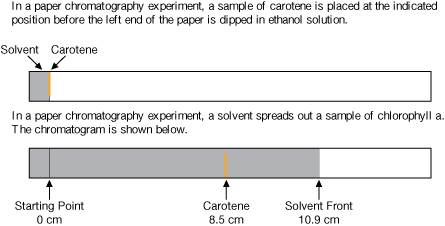Module 5 Intro
1. Module 5 Intro
1.11. Lab
Module 5—Photosynthesis and Cellular Respiration
 LAB. Using Chromatography to Separate Plant Pigments
LAB. Using Chromatography to Separate Plant Pigments
To identify the different pigments present in the leaves of a green plant, a separation process called chromatography is used. Your textbook gives a procedure for “Investigation 5.B: Using Chromatography to Separate Plant Pigments” on pages 172 and 173. If you have access to a lab, you may be instructed to complete this lab as indicated in the textbook. You should not attempt this investigation outside of a lab, since the solvent used is volatile, poisonous, and flammable.
If you do not have access to a lab, you will be given a diagram of pigments separated by chromatography in your assignment.
In this experiment, liquid from crushed leaves is painted onto special paper. The paper is then placed in a test tube containing a solvent. The solvent is absorbed up through the paper and, as the solvent rises, it separates the different pigments. Generally, the pigments with the smallest molecules will move through the paper the fastest, but results may differ when some solvents—or combinations of solvents—are used.
Before you go to your Module 5: Lesson 2 Assignment to complete this Lab, complete the following Self-Check on reference flow.
 Self-Check: Reference Flow
Self-Check: Reference Flow
(Rf) is a measure of how far a substance is transported in chromatography relative to the movement of the solvent used. It is calculated by dividing the distance a substance (pigment) moves by the distance the solvent moves.
![]()

SC 5. Using the measurements shown on the diagram, what is the Rf for carotene?
 Self-Check Answer
Self-Check Answer
SC 5. Rf = 8.5 cm/10.9 cm = 0.78